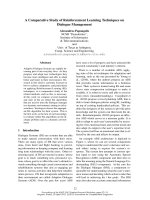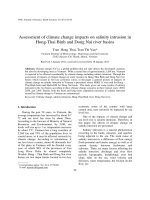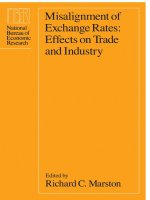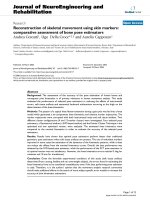Comparative assessment of endoglucanase activity of cellulolytic bacterial strains on untreated and pretreated natural cellulosic wastes
Bạn đang xem bản rút gọn của tài liệu. Xem và tải ngay bản đầy đủ của tài liệu tại đây (517.62 KB, 14 trang )
Int.J.Curr.Microbiol.App.Sci (2020) 9(5): 1974-1987
International Journal of Current Microbiology and Applied Sciences
ISSN: 2319-7706 Volume 9 Number 5 (2020)
Journal homepage:
Original Research Article
/>
Comparative Assessment of Endoglucanase Activity of Cellulolytic
Bacterial Strains on Untreated and Pretreated Natural Cellulosic Wastes
Pinky Prasad1*, Tanuja2 and Sheila Bedi1
1
Department of Botany, Patna Women’s College, Patna University, Patna, Bihar, India
2
Department of Botany, T. P. S. College, Patna, Pataliputra University, Bihar, India
*Corresponding author
ABSTRACT
Keywords
Natural cellulosic
wastes, Cellulolytic
bacterial strains,
Endoglucanase
activity,
Exoglucanase
activity
Article Info
Accepted:
15 April 2020
Available Online:
10 May 2020
The aim of the research was isolation of efficient cellulolytic bacterial strains from soil samples and
comparative assessment of their cellulolytic potential on untreated and pre-treated cellulosic wastes
namely sugarcane bagasse, groundnut shell, corn cob, and vegetable peel so as to determine a suitable
substrate pre-treatment for cellulolytic enzyme production. The substrates were pretreated with 0.5%
NaOH (alkali treatment) and 0.5% HCl (acid treatment) and the endoglucanase enzyme production was
analyzed on untreated, alkali treated and acid treated substrates by measuring the amount of glucose
liberated in IU/ ml by using the dinitrosalicylic acid assay method. A total of 22 cellulose degrading
bacterial strains isolated from 10 soil samples collected randomly from agricultural fields and municipal
wastes from different locations in Patna region were screened after primary screening using Congo red and
out of these, six of the most promising isolates labeled as PCD1, PCD2, PCD3, PCD4, PCD5 and PCD6
were selected for further investigations on the basis of their enzymatic activity. Amplified and sequenced
portion of the 16S rRNA genes of these isolates were BLASTed to determine likely genera and are
deposited in the GenBank with their Accession Numbers. PCD1 was identified as Brevibacillus brevis
(Accession No. KP851193), PCD2 as Streptomyces matensis (Accession No. KP890933), PCD3 as
Ochrobactrum intermedium (Accession No. KP851194), PCD4 as Bacillus subtilis (Accession No.
KP851195), PCD5 as Streptomyces griseorubens (Accession No. KP851196) and PCD6 as Achromobacter
xylosoxidans (Accession No. KP851197). Comparing the enzyme production by all the selected strains on
all the specified untreated and pretreated cellulosic wastes, it was concluded that the maximum amount of
enzyme production (0.2427 IU/ml) was observed on alkali treated sugarcane bagasse by the strain Bacillus
subtilis.
Introduction
Lignocellulosic biomass is the most abundant,
inexpensive and renewable carbohydrate
continuously added in nature by the process
of photosynthesis (~ 100 billion dry tons yr-1)
(Zhang and Lynd, 2004). It is comprised of
mainly cellulose, a homologous polymer of
glucose molecules connected by β-1,4
linkages, some hemicelluloses, a heterologous
polymer of 5- and 6- carbon sugars and least
of all lignin a complex aromatic polymer
(Maki et al., 2011). A major portion of it is
generally not edible and constitutes the
agricultural wastes such as leaves, stems, and
stalks from sources such as corn fibre, corn
1974
Int.J.Curr.Microbiol.App.Sci (2020) 9(5): 1974-1987
stover, sugarcane bagasse, rice hulls, woody
crops, and forest residues etc.; and municipal
wastes such as vegetable peel waste, sawdust,
paper pulp etc. (Maki et al., 2009) which
accumulate in the environment causing
pollution problem. Municipal solid waste is
composed of 40–50% cellulose, 9–12%
hemicelluloses, and 10–15% lignin on a dry
weight basis (Rani and Nand, 2000).
Gautam et al., (2012) reported that Asia
generates 4.4 billion tons of solid wastes
annually, and municipal solid waste
comprises 790 million tons of which about 48
million tons are generated in India.
The bioconversion of lignocellulosic wastes
into food, fuel and chemicals is now a subject
of intensive research and is considered as the
only foreseeable, feasible and sustainable
resource beneficial to mankind. The carbon
liberated by the biodegradation of cellulose
could be widely used to produce sustainable
bio-based products and bioenergy to replace
depleting fossil fuels (Kiranmayi et al., 2011).
Industrial bioconversion of lignocelluloses is
both expensive and time consuming as it
requires multiple steps including physical,
thermal and/ or chemical pretreatment of the
lignocellulosic substrates to break down
lignin, decrease crystallinity, increase pore
volume and solubilise cellulose and
hemicelluloses; saccharification to allow
enzymatic
hydrolysis
of
target
polysaccharides into monosaccharides; and
addition of microorganisms capable of
fermentation of the
monosaccharides to
bioethanol (Maki et al., 2009).
The use of microbial enzymes for
consolidated
bioprocessing
(CBP)
of
lignocellulosic substrates has led to intensive
exploration of natural microbial biodiversity.
Several microorganisms including both
bacteria and fungi have been found to produce
a variety of cellulases for the degradation of
cellulose. Cellulases are a consortium of free
enzymes comprised of endoglucanases (β-1,4D-glucan-4-glucanohydrolase, EC 3.2.1.4,
carboxymethyl cellulase, EC), exoglucanases
(β-1,4-D-glucan-4-glucohydrolase,
EC
3.2.1.91, cellobiohydrolase, CBH), and
cellobiases (β-D-glucoside glucohydrolase,
EC 3.2.1.21, β-1,4-D-glucosidase) are found
in many of the 57 glycosyl hydrolase families
(Siddiqui et al., 2000). Microbial cellulases
are the most economic and available sources,
because microorganisms can grow on
inexpensive media such agricultural residues
and municipal wastes.
The rate and extent of the cellulolytic
hydrolysis of lignocellulosic substrates is
influenced not only by the effectiveness of the
enzymes but also by the chemical, physical
and morphological characteristics of the
heterogeneous
lignocellulosic substrates
(Chandra et al., 2007).
A pretreatment step is essential which
disrupts the highly ordered cellulose structure
and the lignin-carbohydrate complex, remove
lignin, and increase the surface area
accessible to enzymes, promote the
hydrolysis, and increase the rate and extent of
hydrolysis
of
cellulose
in
various
lignocellulosic residues (Fan et al., 1982).
Focusing on the effect of pretreatment of
cellulosic substrates on cellulose degradation,
the present work was intended to compare the
cellulose hydrolysis of untreated, alkali
treated and acid treated cellulosic wastes by
cellulolytic bacterial strains. Accordingly, the
major objectives of the research were
isolation of efficient cellulolytic bacterial
strains from soil samples and comparative
assessment of their cellulolytic potential on
untreated and pre-treated cellulosic wastes
namely sugarcane bagasse, groundnut shell,
corn cob, and vegetable peel.
1975
Int.J.Curr.Microbiol.App.Sci (2020) 9(5): 1974-1987
Materials and Methods
Isolation of bacterial strains from soil
samples
Soil samples were collected randomly from a
depth of 3-4 inches under aseptic condition
from agricultural fields and municipal wastes
from 10 different locations in Patna region.
Soil samples were air dried for one week to
decrease the population of gram negative
bacteria, sieved and plated with fivefold
dilution on CMC agar (Peptone, 5 g; NaCl, 5
g; CMC, 3 g; Agar, 20 g; Distilled water,
1000 ml; pH 7.0) plates in duplicates by serial
dilution method described by Oskay et al.,
(2004). All the plates were incubated for 48 h
at 37 °C. The bacterial colonies obtained were
purified by repeated sub culturing and
maintained on Nutrient Agar slants at 4 °C.
Primary screening of cellulolytic bacterial
strains
The isolated microbes were grown on CMC
agar plates and incubated at 37 °C for one
week. The Petri plates were flooded with
0.1% Congo red solution for 15 minutes, and
then Congo red solution was discarded.
The plates were, then, flooded with 1 N HCl
solution and allowed to stand for 15 minutes.
The strains showing clear zone around the
colonies, where the enzyme had utilized the
cellulose, were selected for secondary
screening.
Secondary
screening
bacterial strains
of
cellulolytic
Potential microbes presenting large clearing
zones in Congo red test were screened for
their cellulase producing ability using CMC
broth. A loopful of the bacterial cultures were
inoculated separately in 50 ml of sterilized
CMC broth in 150 ml Erlenmeyer flask and
incubated in shaker incubator for four days at
37 °C for enzymes production. After
incubation, the cultures were harvested by
centrifugation at 5000 rpm for 10 minutes and
the cell free culture supernatants were
analysed for enzyme activities.
Measurement of enzyme activity
Endoglucanase activity
Endoglucanase (CMCase) activity
was
measured according to the IUPAC
instructions by taking a reaction mixture in a
test tube containing 0.5 ml of 1% CMC in
0.05 M sodium citrate buffer (pH 6) with
0.5ml of enzyme supernatant (Ghose, 1987).
The reaction mixture was incubated at 50 °C
for 30 minutes and to that solution 1 ml of
DNS reagent was added and boiled for five
minutes in the boiling water bath. The amount
of reducing sugar produced was determined
by dinitrosalicylic acid (DNS) method
(Miller, 1959) by taking absorbance at 540
nm using spectrophotometer and comparing it
with the standard glucose curve.
One unit of CMC-ase activity is defined as
the amount of enzyme that released one
μmole of reducing sugar measured as glucose
per minute under the assay conditions.
Exoglucanase activity
Exoglucanase activity or Filter paper activity
(FPase) in the culture filtrate was determined
according to the IUPAC instructions by
taking Whatman number one filter paper strip
(1 × 6 cm or 50 mg) immersed in 1 ml of
0.05 M sodium citrate buffer of pH 6 and
incubating at 50 °C for one hour. The
reducing sugar released was estimated by
dinitrosalicylic acid (DNS) method as
described earlier.
1976
Int.J.Curr.Microbiol.App.Sci (2020) 9(5): 1974-1987
Lignocellulosic sources
The lignocellulosic substrates used for the
present work included sugarcane bagasse,
groundnut shell, corn cob, and vegetable
peels. One kg of each of these cellulosic
substrates were dipped in five litre of distilled
water to remove any soluble sugars present in
them and then dried in hot air oven at 80 °C
for 36 hours. The substrates were then
grounded and sieved through 100 micrometer
mesh size and kept at room temperature.
These untreated substrates were used as
sources of cellulose for determining the
enzyme production by the isolated cellulolytic
bacterial strains.
Pretreatment of cellulosic substrates
The cellulosic substrates were pretreated with
alkali and acid. 100 g of each of the dried and
powdered substrates was treated separately
for 24 hours with 500 ml of each of NaOH
and HCl and then repeatedly washed with
distilled water to obtain a neutral pH. Then
the substrates were dried overnight at 60 °C
and used as sources of cellulose to compare
the enzyme production by the isolated
cellulolytic bacterial strains.
Enzyme production medium
Stainer’s basal medium ((NH4)2SO4 1 g;
K2HPO4 1 g; MgSO4 0.2 g; CaCl2 0.1 g;
FeCl3 0.02 g; Distilled water, 1000 ml;
pH7.5) mixed separately with specified
cellulosic substrates (10 g/l) was used for
cellulase production.
production. The samples were centrifuged at
5000 rpm for 10 minutes. The supernatants
obtained were used for the determination of
CMCase activities by the method described
by Ghose (1987) and for the estimation of
reducing sugar released by the method
described by Miller (1959).
Molecular
characterization
phylogenetic analysis of the
cellulolytic bacteria
and
selected
Genomic DNA extraction
DNA was extracted from 48 hour old culture
broth using DNA Isolation Kit (Qiagen)
according to the manufacturer instructions
and its quality was evaluated on 0.8% (w/v)
Agarose Gel (HiMedia) in an electrophoresis
apparatus (BioRad).
Polymerase chain reaction amplifications
Fragment of 16S rRNA gene was amplified
using PCR kit (Sino-American Biotechnology
Co., Beijing) from the above isolated DNA
according to the manufacturer instructions.
PCR reaction mixture consisted of 1 μl 80 ng
chromosomal DNA, 0.5 μl 200 µM of each
deoxynucleoside triphosphate (New England
Biolabs), 0.8 μl 80 ng Universal primer 27f
(5’-AGAGTTTGATCMTGGCTCAG-3’), 0.8
μl 80 ng Universal primer 1492r (5’TACGGYTACCTTGTTACGACTT-3’):
Escherichia coli 16S rRNA numbering
system (Brosius et. al., 1978), 0.5 μl 2.5 Units
Taq Polymerase enzyme, 2.5 μl 1X Standard
Taq buffer and 18.9 μl autoclaved water to
make the final volume of 25 μl.
Cellulase production
Ten ml of Stainer’s basal medium was
dispensed in 18 tubes each, autoclaved and
inoculated with the six selected bacterial
strains in triplicates. The tubes were incubated
at 37 °C for four days for cellulase
PCR cycling parameters included an initial
denaturation at 95 ºC for five minutes,
followed by 30 cycles of denaturation at 95
°C for one minute, annealing at 55 °C for one
minute and extension at 75 °C for two
minutes and a final extension for ten minutes
1977
Int.J.Curr.Microbiol.App.Sci (2020) 9(5): 1974-1987
at 75 °C. After completion of PCR, the
sample was loaded in a 0.8% Agarose Gel
with a 1 kb DNA marker supplied by NEB
and approximately 1.5 kb amplified 16S
rRNA gene fragment was separated by
agarose gel electrophoresis, extracted using
Qiaquick gel extraction kit (Qiagen) and
purified.
Sequencing of PCR products
Sequencing of the purified PCR products
were conducted at Microbial Type Culture
Collection
(MTCC),
Chandigarh
and
Genomics Services Xcelris Labs Ltd.,
Ahmedabad.
The obtained 16S rRNA sequences were
compared to sequences in the NCBI genebank
database with the Basic Alignment Search
Tool (BLAST) (Altschul et al., 1990). The
16S rRNA gene sequences of the strains are
deposited in GenBank and their accession
numbers have been obtained.
Phylogenetic analysis
Phylogenetic trees were constructed using the
Neighbor-Joining method in MEGA program
version 4.1 (Kumar et al., 2004). The 16S
rDNA gene sequences of the type strains of
the various genera used in this study were
retrieved from the GeneBank database and
used for cladistic analysis. These sequences
have been chosen as reference sequences.
Results and Discussion
Isolation and enumeration of cellulolytic
bacterial strains
From all of the soil samples collected, a total
of 22 cellulose degrading isolates (Figure 1)
were screened after primary screening using
Congo red. Out of these, six cellulaseproducing isolates labeled as PCD1, PCD2,
PCD3, PCD4, PCD5 and PCD6 were selected
after secondary screening by determining
their potentiality for cellulase production.
Endoglucanase activity of the selected isolates
ranged between 15.91 IU/ml and 17.76 IU/ml.
Maximum endoglucanase activity was shown
by PCD1 (17.76 IU/ml). It was same for the
strains PCD2, PCD3, PCD4 and PCD6 and
was found to be 16.65 IU/ml. It was least for
the strain PCD5 (15.91 IU/ml).
Exoglucanase activity of the selected isolates
ranged between 10.36 IU/ml and 11.10 IU/ml.
It was 11.10 IU/ml for the strains PCD1 and
PCD2; 10.73 IU/ml for the strains PCD3 and
PCD4; 10.55 IU/ml for the strain PCD5; and
10.36 IU/ml for the strain PCD6. The data are
shown in Figure 2.
Estimation of endoglucanase production by
the selected bacterial strains on different
untreated and pretreated cellulosic wastes
The production of cellulases using various
substrates and nutrients by fungi and bacteria
has been reported by many workers (Macris et
al., 1989; Krishna, 1999; Lakshmikant and
Mathur, 1990; Immanuel et al., 2006;
Kiranmayi et al., 2011). However, some
workers (Kotchoni et al., 2006; Odeniyi,
2009; Robson and Chambliss, 1984) have
reported that the cellulolytic bacteria
especially the Bacillus strains are capable of
hydrolyzing
amorphous
carboxymethyl
cellulose but there are not sufficient records
on Bacillus species possessing ability to
degrade the more crystalline cellulosic
substrates.
Keeping this in view, the present study was
aimed at determining the endoglucanases
secreted by the selected bacterial isolates
which acts on the amorphous portion of the
cellulosic
substrate.
The
natural
lignocellulosic wastes are difficult to be
1978
Int.J.Curr.Microbiol.App.Sci (2020) 9(5): 1974-1987
hydrolysed by cellulolytic enzymes due to
presence of recalcitrant
lignin
and
hemicelluloses (Mansfield et al., 1999;
Esteghlalian et al., 2001). Besides this,
degree of polymerization and cellulose
crystallinity (Chang and Holtzapple, 2000);
accessible surface area (Taherzadeh and
Karimi, 2008) and pore size of the substrate in
relation to the size of the enzymes (Chandra
et al., 2007) are other limiting factors in the
enzymatic hydrolysis of lignocellulosic
biomass. Thus, the lignocellulosic wastes
were chemically treated separately with alkali
and acid for efficient enzymatic conversion;
and
a
comparative
assessment
of
endoglucanase activity was done.
The
endoglucanase
production
using
sugarcane bagasse by PCD1 in untreated
condition was 0.0444 IU/ml, in acid treated
0.0499 IU/ml and in alkali treated 0.0444
IU/ml. The same by PCD2 was 0.0170 IU/ml
(untreated), 0.0189 IU/ml (acid treated) and
0.0189 IU/ml (alkali treated). For PCD3 the
value was 0.0163 IU/ml (untreated), 0.0244
IU/ml (acid treated), 0.0192 IU/ml (alkali
treated); for PCD4 it was 0.0481 IU/ml
(untreated), 0.0858 IU/ml (acid treated),
0.2427 IU/ml (alkali treated); for PCD5 it was
0.0407 IU/ml (untreated), 0.0437 IU/ml (acid
treated), 0.0647 IU/ml (alkali treated); for
PCD6 it was 0.0181 IU/ml (untreated), 0.0233
IU/ml (acid treated), 0.0215 IU/ml (alkali
treated). The data has been presented in
Figure 3.
The endoglucanase production using corn cob
by PCD1 in untreated condition was 0.0573
IU/ml, in acid treated 0.0651 IU/ml and in
alkali treated 0.0740 IU/ml. The same by
PCD2 was 0.0185 IU/ml (untreated), 0.0196
IU/ml (acid treated) and 0.0189 IU/ml (alkali
treated). For PCD3 the value was 0.0160
IU/ml (untreated), 0.0250 IU/ml (acid
treated), 0.1920 IU/ml (alkali treated); for
PCD4 it was 0.1232 IU/ml (untreated), 0.1591
IU/ml (acid treated), 0.1776 IU/ml (alkali
treated); for PCD5 it was 0.0385 IU/ml
(untreated), 0.0444 IU/ml (acid treated),
0.0795 IU/ml (alkali treated); for PCD6 it was
0.0192 IU/ml (untreated), 0.0216 IU/ml (acid
treated), 0.0201 IU/ml (alkali treated). The
data has been presented in Figure 4.
The
endoglucanase
production
using
groundnut shell by PCD1 in untreated
condition was 0.0573 IU/ml, in acid treated
0.0851 IU/ml and in alkali treated 0.0573
IU/ml. The same by PCD2 was 0.0181 IU/ml
(untreated), 0.0185 IU/ml (acid treated) and
0.0233 IU/ml (alkali treated). For PCD3 the
value was 0.0160 IU/ml (untreated), 0.0259
IU/ml (acid treated), 0.0174 IU/ml (alkali
treated); for PCD4 it was 0.0388 IU/ml
(untreated), 0.0414 IU/ml (acid treated),
0.0507 IU/ml (alkali treated); for PCD5 it was
0.0370 IU/ml (untreated), 0.0425 IU/ml (acid
treated), 0.0425 IU/ml (alkali treated); for
PCD6 it was 0.0174 IU/ml (untreated), 0.0244
IU/ml (acid treated), 0.0174 IU/ml (alkali
treated). The data has been presented in
Figure 5.
The
endoglucanase
production
using
vegetable peel by PCD1 in untreated
condition was 0.0518 IU/ml, in acid treated
0.0536 IU/ml and in alkali treated 0.0832
IU/ml. The same by PCD2 was 0.0174 IU/ml
(untreated), 0.0189 IU/ml (acid treated) and
0.0181 IU/ml (alkali treated).
For PCD3 the value was 0.0166 IU/ml
(untreated), 0.0215 IU/ml (acid treated),
0.0185 IU/ml (alkali treated); for PCD4 it was
0.0451 IU/ml (untreated), 0.0466 IU/ml (acid
treated), 0.0784 IU/ml (alkali treated); for
PCD5 it was 0.0444 IU/ml (untreated), 0.0555
IU/ml (acid treated), 0.0499 IU/ml (alkali
treated); for PCD6 it was 0.0196 IU/ml
(untreated), 0.0207 IU/ml (acid treated),
0.1960 IU/ml (alkali treated). The data has
been presented in Figure 6.
1979
Int.J.Curr.Microbiol.App.Sci (2020) 9(5): 1974-1987
It was found that in all cases, the
endoglucanase activity was more in the
pretreated cellulosic wastes as compared to
the untreated ones indicating the effectiveness
of pretreatment of substrates in achieving
acceptable
enzymatic
digestibility.
Pretreatment alters or removes the physical
and chemical impediments that inhibit the
accessibility of the enzyme to the substrates.
In the present study, the alkali treatment of
cellulosic wastes was found superior
compared to acid treatment for enzymatic
hydrolysis.
Alkali pretreatment method which is more
effective on agricultural residues than on
wood materials (Kumar and Wyman,2009)
causes swelling, increasing the internal
surface of cellulose and decreasing the degree
of polymerization and crystallinity, which
provokes lignin disruption (Playne, 1984).
However, acid treatment of groundnut shell
proved to be better substrate for enzyme
production by the strains PCD1, PCD3 and
PCD6. But acid treatment of substrate
generates toxic degradation products (Saritha
et al., 2012), hence, should be avoided.
The degradation of sugarcane bagasse ranged
between 0.0189 IU/ml and 0.2427 IU/ml by
the selected isolates in four days; that of corn
cob between 0.0189 IU/ml and 0.0740 IU/ml;
that of groundnut shells between 0.0174
IU/ml and 0.0.573 IU/ml; and that of
vegetable peel between 0.0181 IU/ml and
0.1960 IU/ml.
Regarding the enzymatic efficiency of the
isolates, it was observed that PCD4 was able
to degrade all of the substrates used in the
present study considerably as compared to the
other isolates. It was the most efficient strain
in degrading sugarcane bagasse; second to
PCD3 in degrading corn cob and PCD1 in
degrading groundnut shell, respectively. In
degrading vegetable peel its position was after
PCD6 and PCD1 as shown in Table 1.
Comparing the enzyme production by all the
selected strains on all the specified untreated
and pretreated cellulosic wastes, it was
concluded that the maximum amount of
enzyme production was observed on alkali
treated sugarcane bagasse by the strain PCD4
in four days.
Identification of the selected cellulolytic
bacterial strains
The purified and amplified PCR products of
strains PCD1, PCD2 and PCD5 were
sequenced at MTCC, Chandigarh; and that of
the strains PCD3, PCD4 and PCD6 were
sequenced at Genomics Services Xcelris Labs
Ltd., Ahmedabad. The results obtained from
the sequencing of these isolates were inputted
to the nucleotide blast feature of the NCBI
database to obtain possible identities based on
homology (Table 2).
The 16S rRNA sequences of strains
determined in this study have been deposited
in the GenBank database with their Accession
Numbers. PCD1 showed 99% homology with
Brevibacillus brevis and is deposited in the
Genbank with Accession No. KP851193.
PCD2, PCD3, PCD4 and PCD5 showed
100% homology with Streptomyces matensis
(Accession No. KP890933), Ochrobactrum
intermedium (Accession No. KP851194),
Bacillus subtilis (Accession No. KP851195)
and Streptomyces griseorubens (Accession
No. KP851196), respectively. PCD6 showed
99%
homology
with
Achromobacter
xylosoxidans and is deposited in the Genbank
with Accession No. KP851197.
Phylogenetic analysis
The evolutionary history was inferred using
the Neighbor-Joining method . Phylogenetic
trees of all of the selected isolates are
presented from Figure 7 ̶ 12.
1980
Int.J.Curr.Microbiol.App.Sci (2020) 9(5): 1974-1987
Table.1 Enzymatic efficiency of isolates in degrading substrates in four days
S.N.
Three most efficient cellulolytic isolates in ascending
order
Substrate
1
Sugarcane
bagasse
PCD4
(0.2427 IU/ml)
PCD5
(0.0647 IU/ml)
PCD1
(0.0444 IU/ml)
2
Corn cob
PCD3
(0.1920 IU/ml)
PCD4
(0.1776 IU/ml)
PCD5
(0.0795 IU/ml)
3
Groundnut
shell
PCD1
(0.0573 IU/ml)
PCD4
(0.0507 IU/ml)
PCD5
(0.0425 IU/ml)
4
Vegetable
peel
PCD6
(0.1960 IU/ml)
PCD1
(0.0832 IU/ml)
PCD4
(0.0784 IU/ml)
Table.2 BLAST search results for the sequenced cellulase producing isolates
S.N.
Isolate
Homology (%)
Organism
1
PCD1
99
Brevibacillus brevis
2
PCD2
100
Streptomyces matensis
3
PCD3
100
Ochrobactrum intermedium
4
PCD4
100
Bacillus subtilis
5
PCD5
100
Streptomyces griseorubens
6
PCD6
99
Achromobacter xylosoxidans
Fig.1 Cellulose degrading bacterial strains screened after primary screening
1981
Int.J.Curr.Microbiol.App.Sci (2020) 9(5): 1974-1987
Fig.2 Determination of cellulase production by the selected cellulose degrading bacterial strains
Fig.3 Endoglucanase production by the isolates using sugarcane bagasse as substrate
Fig.4 Endoglucanase production by the isolates using corn cob as substrate
1982
Int.J.Curr.Microbiol.App.Sci (2020) 9(5): 1974-1987
Fig.5 Endoglucanase production by the isolates using groundnut shell as substrate
Fig.6 Endoglucanase production by the isolates using vegetable peel as substrate
Fig.7 Phylogenetic Neighbor-Joining tree of the isolate PCD1
1983
Int.J.Curr.Microbiol.App.Sci (2020) 9(5): 1974-1987
Fig.8 Phylogenetic Neighbor-Joining tree of the isolate PCD2
Fig.9 Phylogenetic Neighbor-Joining tree of the isolate PCD3
Fig.10 Phylogenetic Neighbor-Joining tree of the isolate PCD4
1984
Int.J.Curr.Microbiol.App.Sci (2020) 9(5): 1974-1987
Fig.11 Phylogenetic Neighbor-Joining tree of the isolate PCD5
Fig.12 Phylogenetic Neighbor-Joining tree of the isolate PCD6
Based on the reported results, it may be
concluded that alkali treated sugar cane
bagasse can be a potential substrate for
production of cellulase using the bacterial
strain Bacillus subtilis. The aim of this work
is to produce cellulase from natural cellulosic
wastes and reduce the pollution.
Acknowledgements
The authors gratefully acknowledge DST,
Ministry of Science and Technology, Govt. of
India for financial support under WOS-A
scheme and Sister Marie Jessie, Principal,
Patna Women’s College for providing
necessary infrastructural facilities.
References
Altschul, S. F., Jenkins, A., Kristiansen, B. E.
and FrØholm, C. O. (1990). Basic local
alignment search tool
. Journal of
Molecular Biology, 215, 403 ̶ 410.
Brosius, J., Palmer M. L., Kennedy P. J. and
Noller H. F. (1978). Complete
nucleotide sequence of a 16S ribosomal
RNA gene from Escherichia coli.
Proceedings of the National Academy
of Sciences of the United States of
America 75(10), 4801-4805.
Chandra, R. P., Bura, R., Mabee, W. E.,
Berlin, A., Pan, X. and Saddler, J. N.
(2007). Substrate pretreatment: the key
1985
Int.J.Curr.Microbiol.App.Sci (2020) 9(5): 1974-1987
to effective enzymatic hydrolysis of
lignocellulosics?
Advances
in
Biochemical
Engineering/
Biotechnology, 108, 67–93.
Chang, V. S. and Holtzapple, M. (2000).
Fundamental factors affecting biomass
reactivity. Applied Biochemistry and
Biotechnology, 84, 5–37.
Esteghlalian, A. R., Srivastava, V., Gilkes, N.,
Gregg, D. J. and Saddler, J. N. (2001).
An overview of factors influencing the
enzymatic hydrolysis of lignocellulosic
feedstocks. In: Himmel, M.E., Baker,
W. and Saddler, J.N. (eds.), Glycosyl
hydrolases
for
biomass
conversion, Washington, DC, ACS, pp.
100–111.
Fan, L. T., Young-Hyun, L. and Gharpuray,
M. M. (1982). The nature of
lignocellulosics and their pretreatments
for enzymatic hydrolysis. Advances in
Biochemical Engineering, 23, 157–187.
Gautam, S. P., Bundela, P. S., Pandey, A.
K. Jamaluddin, Awasthi, M. K. and
Sarsaiya, S. (2012). Diversity of
Cellulolytic
Microbes
and
the
Biodegradation of Municipal Solid
Waste
by
a
Potential
Strain.
International Journal of Microbiology,
Vol 2012.
Ghose, T. K. (1987). Measurement of
cellulase activities. Pure and Applied
Chemistry, 59, 257–68.
Immanuel, G., Dhanusa, R., Prema, P. and
Palavesam, A. (2006). Effect of
different
growth
parameters
on
endoglucanase enzyme activity by
bacteria isolated from coir retting
effluents of estuarine environment.
International Journal of Environmental
Science and Technology, 3, 25–34.
Kiranmayi, M. U., Poda, S., Vijayalakshmi,
M. and Krishna, P. V. (2011). Studies
on influence of natural biowastes on
cellulase production by Aspergillus
niger. Journal of Environmental
Biology, 32, 695–699.
Kotchoni, S. O., Gachomo, E. W., Omafuvbe,
B. O. and Shonukan, O. O. (2006).
Purification
and
Biochemical
Characterization of Carboxymethyl
Cellulase (CMCase) from a Catabolite
Repression Insensitive Mutant of
Bacillus pumilus. International Journal
of Agriculture and Biology, 8(2), 286–
292.
Krishna, C. (1999). Production of bacterial
cellulases by solid state bioprocessing
banana
wastes.
Bioresource
Technology, 69, 231–239.
Kumar, R. and Wyman, C. E. (2009). Effects
of cellulase and xylanase enzymes on
the deconstruction of solids from
pretreatment of poplar by leading
technologies. Biotechnology Progress,
25,302–314.
Kumar, S., Tamura, K. and Nei, M.
(2004). MEGA3: Integrated software
for molecular evolutionary genetics
analysis and sequence alignment.
Briefings in Bioinformatics, 5, 150–
163.
Lakshmikant, K. and Mathur, S. N. (1990).
Cellulolytic activities of Chaetomium
globosum on different cellulosic
substrates.
World
Journal
of
Microbiology and Biotechnology, 11,
23–26.
Macris, B. J., Kekos, D. and Evrangelidou, X.
(1989). A simple and inexpensive
method for cellulase and b-glusidase
production by Aspergillus niger.
Applied
Microbiology
and
Biotechnology, 31, 150–151.
Maki M. L., Broere M., Leung, K. T. and Qin
W. (2011). Characterization of some
efficient cellulase producing bacteria
isolated from paper mill sludge and
organic fertilizers. International Journal
of Biochemistry and Molecular
Biology, 2(2), 146-154.
Maki, M., Leung, K. T. and Qin, W. (2009).
1986
Int.J.Curr.Microbiol.App.Sci (2020) 9(5): 1974-1987
The prospects of cellulase-producing
bacteria for the bioconversion of
lignocellulosic biomass. International
Journal of Biological Sciences, 5(5),
500–516.
Mansfield, S. D., Mooney, C. and Saddler, J.
N. (1999). Substrate and enzyme
characteristics that limit cellulose
hydrolysis. Biotechnology Progress, 15,
804–816.
Miller, G. L. (1959). Use of dinitrosalicylic
acid reagent for determination of
Reducing sugar. Analytical Chemistry,
31, 426–428.
Odeniyi, O. A., Onilude, A. A. and Ayodele,
M. A. (2009). Production characteristics
and
properties
of
cellulase/
polygalacturonase by a Bacillus
coagulans strain from a fermenting
palm-fruit industrial residue. African
Journal of Microbiology Research, 3(8),
407–417.
Oskay, M., Same, A. and Azeri, C. (2004).
Antibacterial
activity
of
some
actinomycetes isolated from farming
soils of Turkey. Africal Journal of
Biotechnology, 3, 441–446.
Playne, M. J. (1984). Increased digestibility
of bagasse by pretreatment with alkalis
and steam explosion. Biotechnology
and Bioengineering, 26, 426–433.
Rani, D. S. and Nand, K. (2000). Production
of thermostable cellulase-free xylanase
by Clostridium
absonumCFR-702.
Process Biochemistry, 36(4), 355–362.
Robson, L. M. and Chambliss, G. H. (1984).
Characterization of the Cellulolytic
Activity of a Bacillus Isolate. Applied
and
Environmental
Microbiology,
47(5), 1039–1046.
Saritha, M., Arora, A. and Lata. (2012).
Biological
Pretreatment
of
Lignocellulosic Substrates for Enhanced
Delignification
and
Enzymatic
Digestibility.
Indian
Journal
of
Microbiology, 52(2), 122–130.
Siddiqui, K. S., Saqio, A. A. N., Rashid, M.
H. and Rajoka, M. I. (2000). Carboxyl
group modification significantly altered
the kinetic properties of purified
carboxymethyl
cellulase
from Aspergillus niger. Enzyme and
Microbial Technology, 27, 467–474.
Taherzadeh, J. M. and Karimi, K. (2008).
Pretreatment of lignocellulosic wastes
to improve ethanol and biogas
production: a review. International
Journal of Molecular Sciences, 9, 1621–
1651.
Zhang, Y. H. P. and Lynd, L. R. (2004).
Toward an aggregated understanding of
enzymatic hydrolysis of cellulose:
Noncomplexed
cellulase
systems.
Biotechnology and Bioengineering, 88,
797–824.
How to cite this article:
Pinky Prasad, Tanuja and Sheila Bedi. 2020. Comparative Assessment of Endoglucanase
Activity of Cellulolytic Bacterial Strains on Untreated and Pretreated Natural Cellulosic
Wastes. Int.J.Curr.Microbiol.App.Sci. 9(05): 1974-1987.
doi: />
1987









